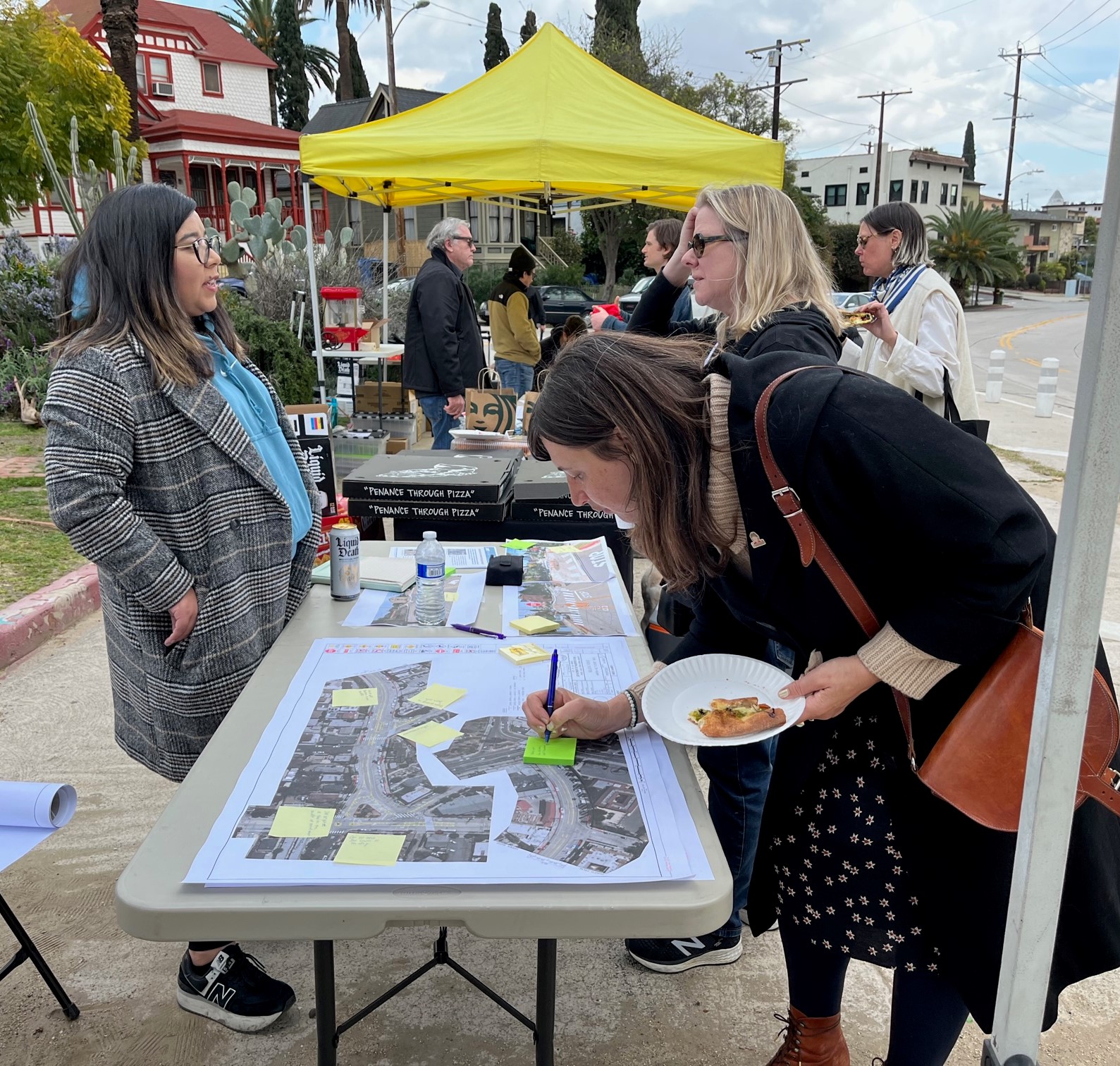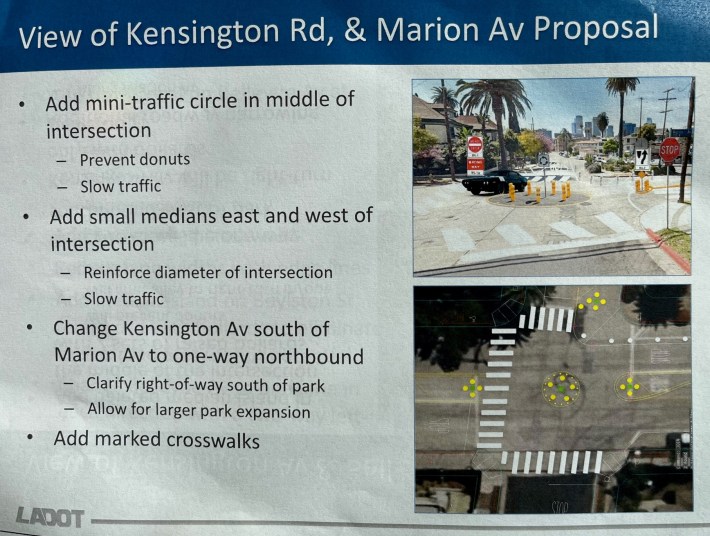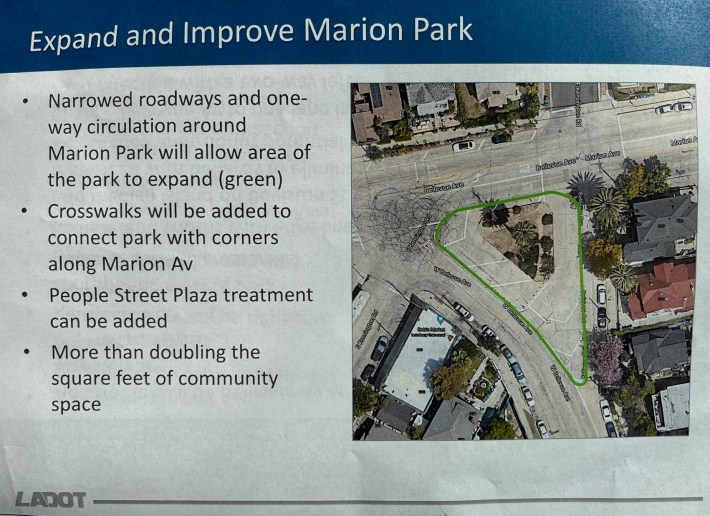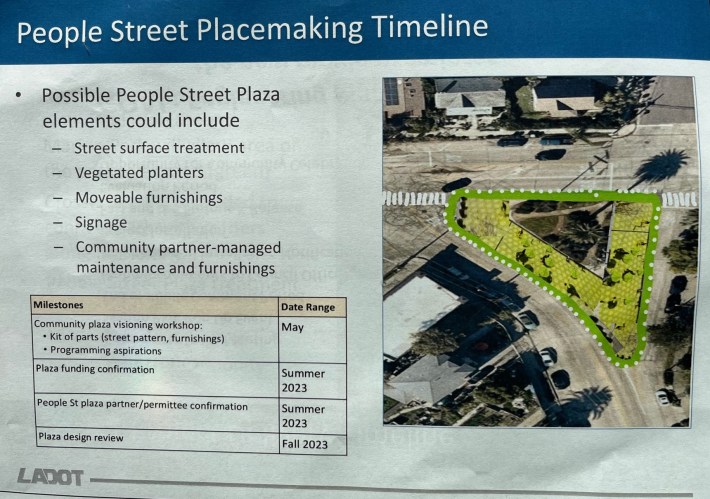
The central Los Angeles neighborhood of Angelino Heights has a traffic violence problem exacerbated by its appearance in Fast & Furious films. Racing film devotees frequently flock to the historic neighborhood to rev their engines and do donuts. Racing stunt noise is disruptive, and neighbors report some collisions and many close calls.
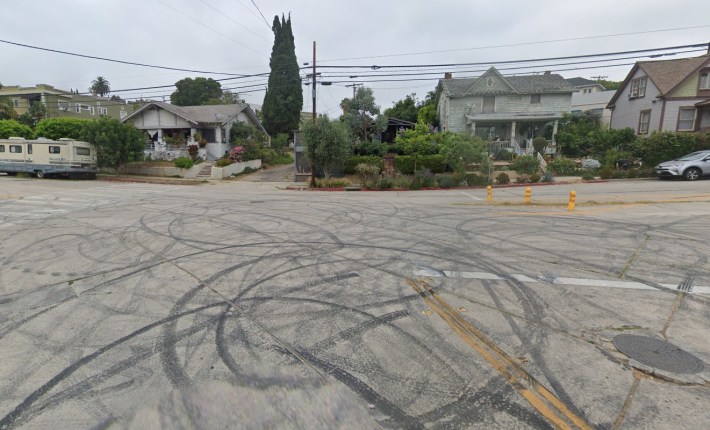
For a few years Angelino Heights residents have been pressing the city to do something to curb illegal racing activity. Under the previous City Councilmember Gil Cedillo, the city Transportation Department (LADOT) installed modest safety improvements comprised of paint and plastic bollards. LADOT (in a recent project handout) now acknowledges that their "previous design was underwhelming."
With a new Fast & Furious sequel due out on May 19, there has been a renewed push for the city to install further safety upgrades.
Last weekend, LADOT, the office of City Councilmember Eunisses Hernandez, and the nonprofit Streets Are For Everyone (SAFE) hosted a drop-in community input workshop at Angelino Heights' Marion Park. LADOT shared its proposed Angelino Heights Roadway Redesign. Stakeholders gave input on the proposal. Occasional aggressive drivers also drove past loudly revving their engines, showing the validity of the neighborhood's concerns.
Angelino Heights streets are over-wide; the streets most plagued by racing (Bellevue Avenue, Marion Avenue, and Boylston Street) are 55-60 feet wide, about half-again as wide the city's 40-foot wide default for two-lane streets with on-street parking. That means there is a lot of space to reimagine and reprogram.
So what is LADOT planning now? More paint and more plastic bollards. Plus the city wants to reward drivers by add more parking (new diagonal parking) and a new center turn lane (unnecessary and counterproductive on a two-lane residential street).
Below are images from LADOT's presentation and handout, which are not available online.

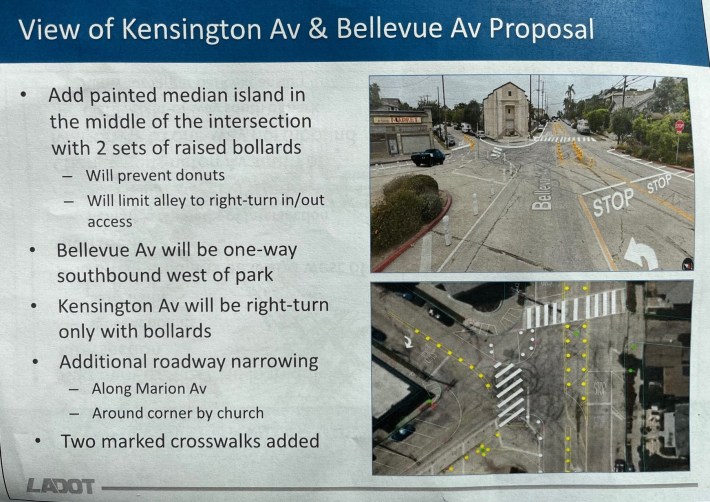
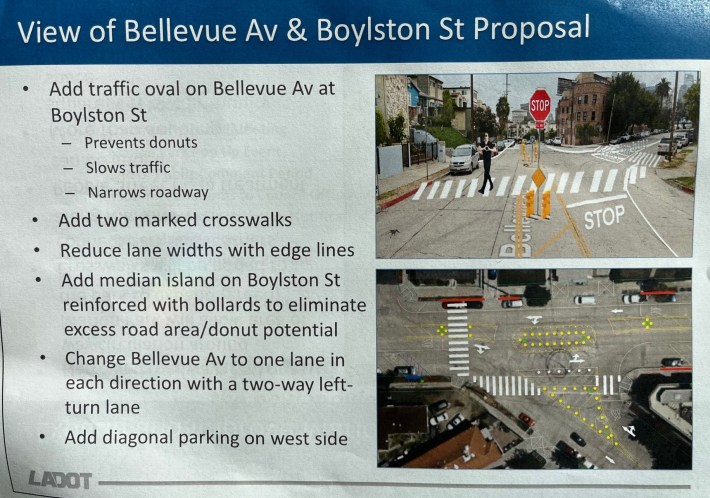
The new design is not awful, but doesn't quite rise to addressing the community's needs.
New crosswalks would acknowledge the presence of pedestrians, and would make them safer. A couple of plastic-bollard-lined traffic circles/median islands would visually narrow the street somewhat. Converting a short portion of Bellevue Avenue (next to the park) to one-way gives pedestrians fewer lanes to cross (but DOT then undermines this lane and road narrowing by reallocating saved lane space to an unnecessary center turn lane).
A proposed later phase would include a potential People St plaza surrounding the small triangular park.
Sadly the kinds of Furious-wannabe racers who rev engines and spin donuts will eat plastic bollards for breakfast. As LADOT has found there and in other L.A. neighborhoods, drivers plow through plastic bollards, damaging and dismantling them.
What would Streetsblog L.A. do?
Instead of just tepidly nudging drivers away from dangerous illegal activity, Angelino Heights streets really do need to be narrower. And instead of just discouraging driving, street redesigns should encourage cleaner, safer, quieter transportation modes: walking and bicycling. For Angelino Heights, LADOT included some features that encourage walking, but omitted bicycle features entirely (except for the protected bike lane shown on the cover of its project handout). On two-lane 60-feet wide streets, LADOT couldn't find an inch to dedicate to bicycling.
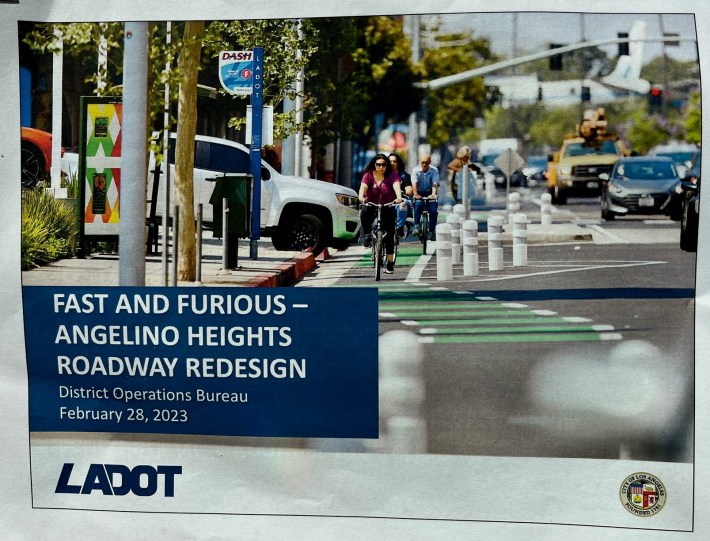
It sure looks like this redesign was formulated to pass muster for the previous stridently anti-bike councilmember, and not for Hernandez, who campaigned on "redesign[ing] the way we get around” including "bike lane installation" and "closing off major streets to build walking plazas."
In my piece suggesting potential mobility improvements for the incoming councilmember, I suggested parking-protected bike lanes in Angelino Heights. Instead of using paint and plastic bollards to suggest narrower lanes, parking-protected bike lanes would move parked cars ~6-10 feet away from the curb, effectively narrowing the roadway by ~12-20 feet. Drivers doing donuts would have to maneuver around real barriers (parked cars - which they already are hitting today), not just flimsy plastic posts. Instead of rewarding drivers by adding more parking and new turn lanes, adding protected lanes would reward bicyclists and pedestrians.
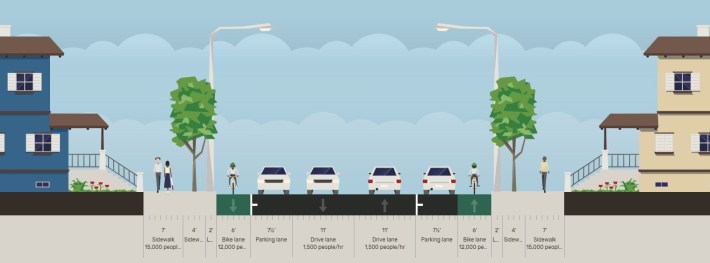
It may be possible (and could potentially narrow the street even more) to do both diagonal parking and protected bike lanes, as LADOT recently installed on Sylmar's 64-feet wide Eldridge Avenue.
If LADOT somehow doesn't do bike lanes here, they need to look to stiffer measures than plastic bollards.
Ideally LADOT should be adding real concrete curbs (the kind that LADOT uses to divert cut-through traffic away from rich neighborhoods) here, but curb-work is not cheap or quick. Why not add real metal bollards, not plastic "soft-hit post" bollards? Any entity truly interested in keeping drivers out of pedestrian space uses real bollards, not plastic ones. The city has real bollards installed in numerous locations - at LAX, multiple places in Little Tokyo, L.A. Live, El Pueblo, Metro Pico Station, at various federal buildings, etc. Real bollards really work. Plastic bollards are designed to minimize dents or scratches on cars.
And while I am backpedaling, if LADOT won't do real bike lanes or real bollards, how about planters? Again, like LADOT does in rich neighborhoods and at People St plazas, these would be planters large enough to stop street racer wannabes. Another alternative would be Jersey Barriers, which can be painted artistically or a neutral color, like green Metro A Line barriers downtown. These barriers work a hundred percent better than (and don't look any worse than) dozens of plastic bollards.
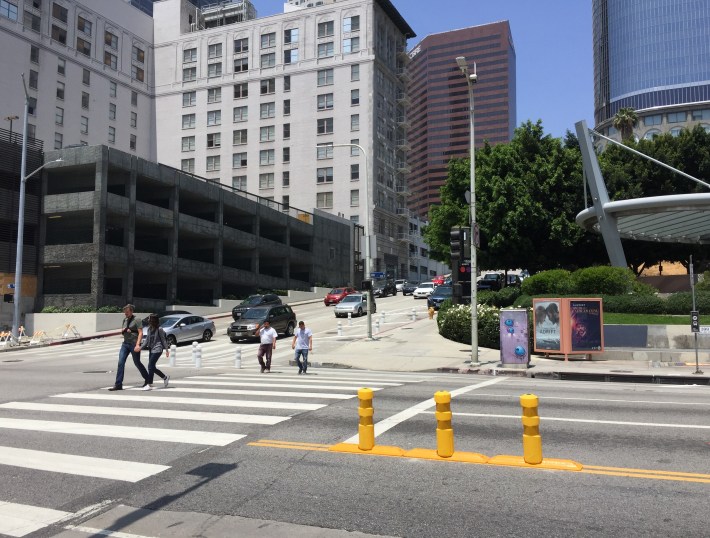
To further backpedal, at a disappointing bare minimum, if LADOT is somehow set on plastic bollards, they should include some sort of solid plastic speed-bump base, like the city has uses on left turn wedges including in front of City Hall, and similar to (inadequate) plastic protection on the 6th Street Bridge.
But really, the city should do even better.
LADOT should get behind Councilmember Hernandez' pledge to close off major streets to build walking plazas. How could that play out here?
Angelino Heights could benefit from permanently closing a few streets off to driving, while allowing walk and bike access (again like LADOT does for well-off areas). This could take the form of plazas and/or diverters. Both of these treatments would preserve driver access to all existing driveways, though they would force some driving trips to be a couple blocks longer.
LADOT is proposing a possible future People St plaza, which isn't bad, but they seem to have carefully sited it as to minimize any impacts to drivers, which basically misses the point.

Street closure plaza plans needs to be developed through a community process (not just tossed out by some blogger like me), but LADOT should look at permanent street closures for short portions of Bellevue where donut activity is worst. LADOT's People St plaza concept could be extended north and/or west to close off portions of Bellevue Avenue. These plazas would potentially eliminate a small number of on-street parking spaces. LADOT should quantify this, and share it with the community.
Diverter/s would close streets to driving while taking away even less road space than plazas. Diverters would preserve existing on-street parking.
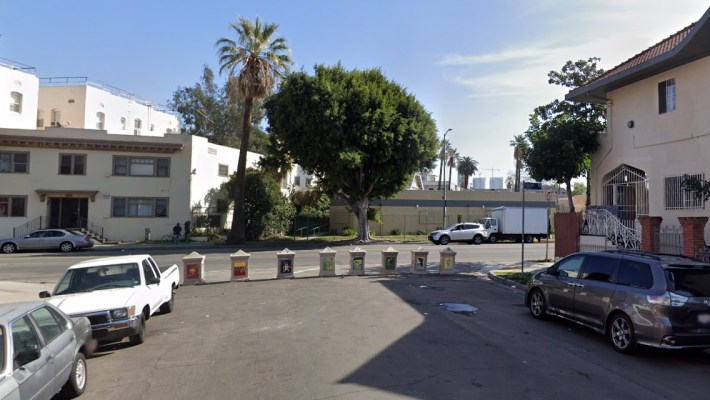
The type of diverter that might make sense is already in use in CD1's Pico Union. It would be a linear barrier, permeable to bike/ped access, but preventing drivers from proceeding directly through.

The first place I would put diverters would be directly through intersections where drivers frequently do donuts: Bellevue/Kensington and Bellevue/Boylston.
These sorts of plazas and diverters could initially be quick-build pilots projects, with paint and temporary barriers like planters. Though LADOT, Councilmember Hernandez, and Angelino Heights neighbors will need to act quickly if they are to devise and implement effective traffic safety measures in time for the upcoming sequel.
